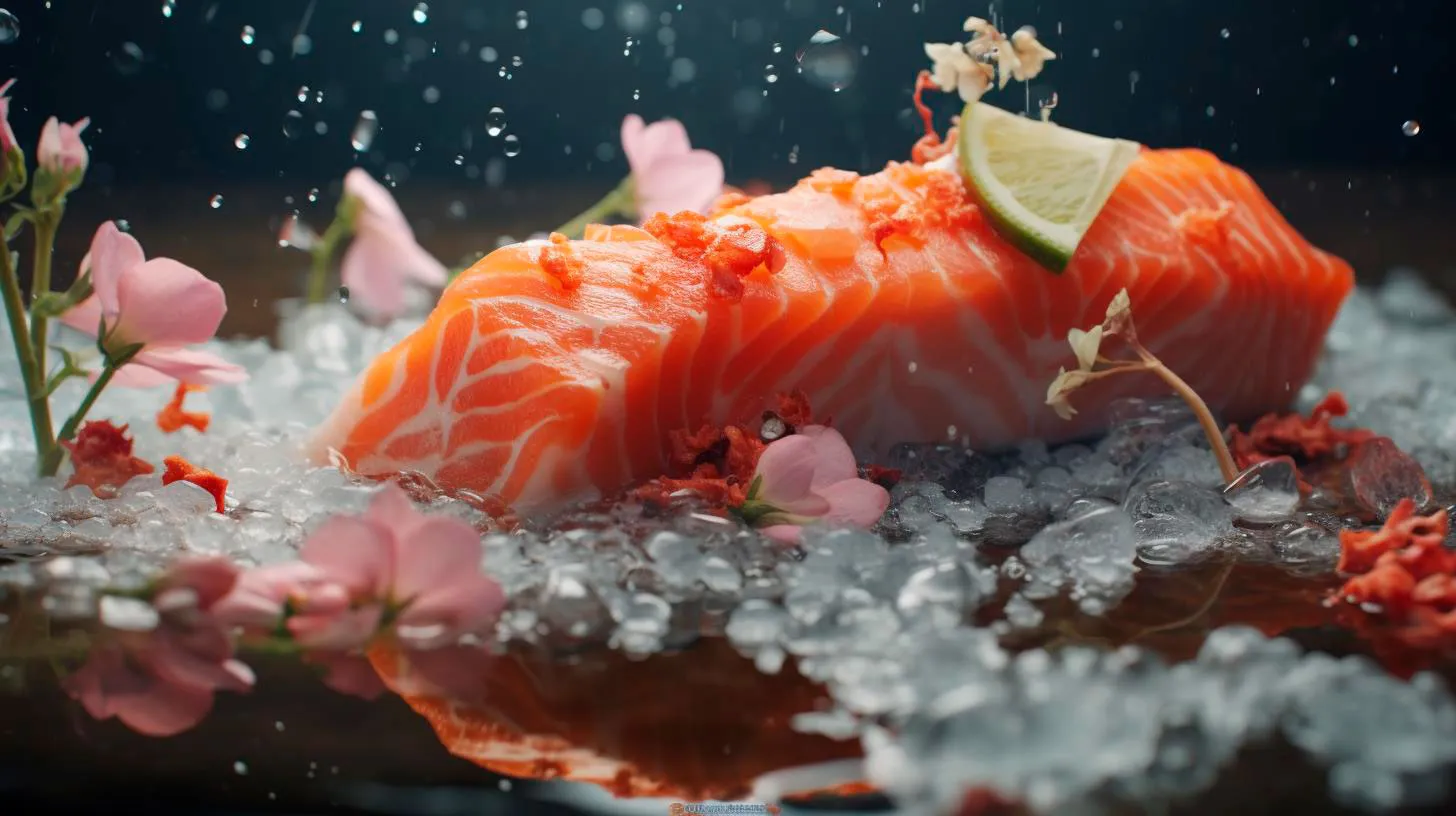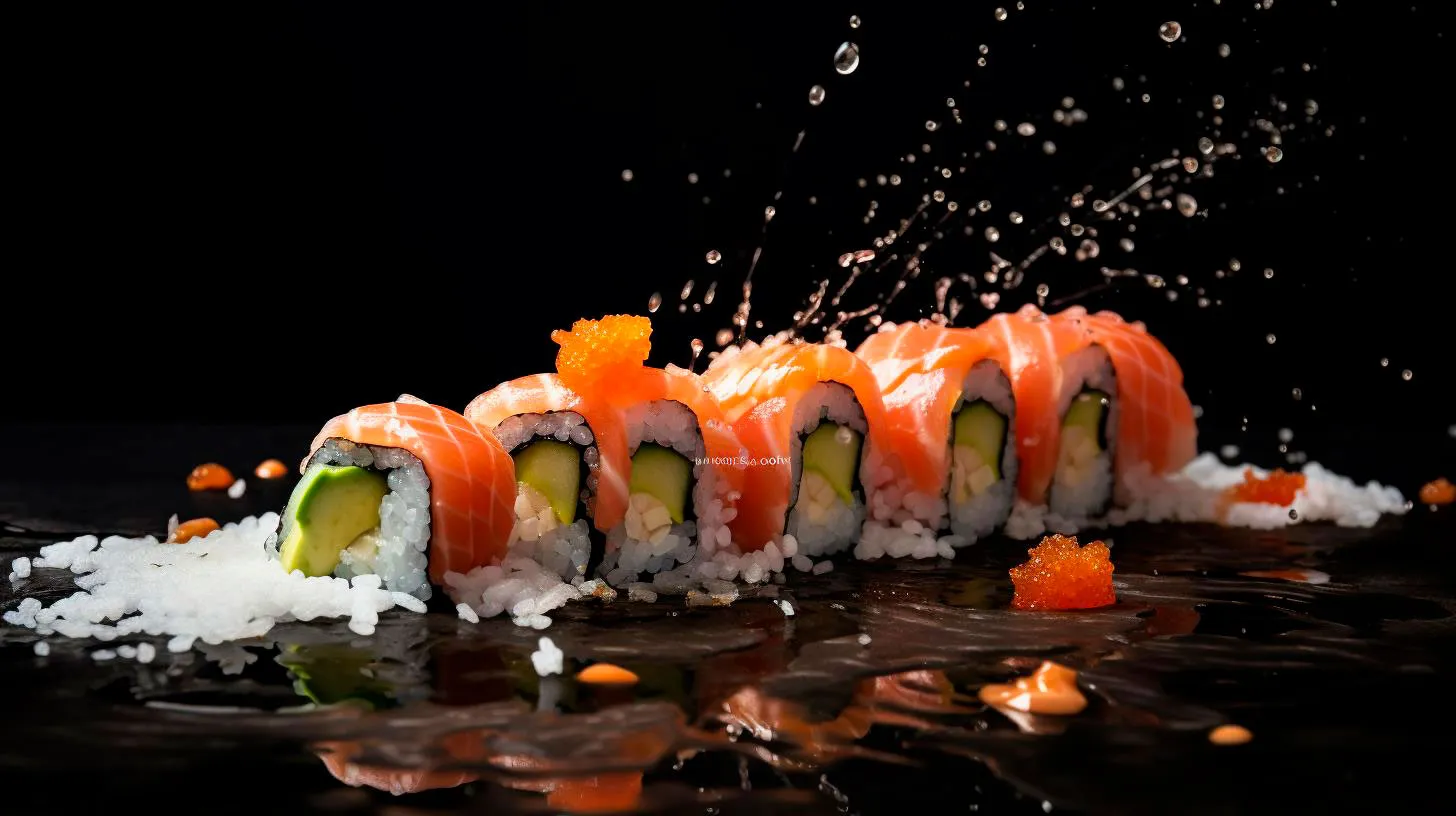The Art of Sushi: Mastering Exquisite Presentation
In this article, we delve into the art of sushi and how to master the exquisite presentation that makes it a feast for the eyes.
The Role of Presentation in Sushi
When it comes to sushi, presentation plays a crucial role in elevating the dining experience. A visually stunning sushi platter not only enhances the overall aesthetics of the dish but also signifies the chef’s skill and attention to detail. A well-presented plate of sushi can increase appetite, create excitement, and even leave a lasting impression on the diner.
In the world of sushi, there are several key elements that contribute to a visually striking presentation:
- Colorful Ingredients: Incorporating a variety of vibrant and contrasting colors adds visual interest to the sushi platter. From the rich red of tuna to the bright green of avocado, the use of colorful ingredients enhances the overall appeal.
- Balance and Symmetry: Arranging sushi pieces with symmetry and balance not only pleases the eye but also brings harmony to the plate. Skilled sushi chefs pay close attention to the placement of each element, creating a visually pleasing composition.
- Texture and Height: Incorporating a mix of textures and creating varying heights adds dimension to the sushi presentation. The interplay of soft, crispy, and crunchy textures not only stimulates the palate but also adds visual depth.
- Garnishes and Accents: Skillfully placed garnishes, such as microgreens, edible flowers, and delicate sauces, can elevate the overall presentation of the sushi platter. These small accents can bring out the flavors and add a touch of elegance.
Steps to Master Sushi Presentation
To create a visually stunning sushi presentation, follow these steps:
1. Use Fresh and Quality Ingredients
Sushi relies heavily on the freshness and quality of its ingredients. Fresh fish, crisp vegetables, and perfectly cooked sushi rice are essential for both taste and presentation. Look for suppliers who provide high-quality, sushi-grade ingredients to ensure your sushi stands out.
2. Invest in Proper Tools
Investing in the right tools is crucial for sushi presentation mastery. High-quality Japanese knives, bamboo rolling mats, and precise cutting tools enable you to create clean and precise cuts, enhancing the overall appearance of the sushi.
3. Practice the Art of Cutting
Cutting fish and other ingredients precisely is a skill that sushi masters perfect through dedicated practice. Mastering the art of cutting ensures uniformity in shape and size, contributing to the visual appeal of the sushi. Take the time to hone your cutting techniques to achieve consistent results.
4. Experiment with Different Arrangements
Don’t be afraid to break from tradition and experiment with various arrangement styles. Whether it’s a classic linear presentation, an intricate flower pattern, or a contemporary geometric design, let your creativity shine through. Experimentation can lead to unique and captivating sushi presentations.
5. Presentation Accompaniments
Consider the entire presentation when creating sushi masterpieces. Use traditional wooden or ceramic sushi plates that complement the colors and textures of the sushi. Appropriately sized chopsticks, soy sauce dishes, and wasabi containers add to the overall aesthetic appeal of the dining experience.
Key Takeaways
- Sushi presentation is an essential aspect of this Japanese culinary art form.
- Colorful ingredients, balance, symmetry, texture, and height contribute to visually striking sushi presentations.
- Using fresh, high-quality ingredients is crucial for both taste and presentation.
- Invest in proper tools and practice precise cutting techniques.
- Experiment with different arrangement styles to create unique sushi presentations.
- Consider the presentation accompaniments such as plates, chopsticks, and soy sauce dishes.
Mastering the art of sushi presentation takes time, practice, and a keen eye for detail. As you explore the world of sushi, remember that each plate you create should be a work of art that entices both the eyes and the taste buds. With dedication and creativity, you can master the exquisite presentation of sushi, creating memorable dining experiences for yourself and your guests.
Unveiling Culinary Perfection: The Role of Detail in Sushi
In this article, we delve into the world of sushi and explore the pivotal role that detail plays in creating this exceptional cuisine.
The Essence of Sushi: Artistry on a Plate
Sushi, often epitomized by its simple appearance, is a testament to the Japanese philosophy of minimalism. However, beneath its seemingly straightforward presentation lies an intricate blend of flavors, textures, and aesthetics that make sushi truly exceptional. While its core ingredients consist of vinegared rice and raw or cooked seafood, it is the way these components are carefully combined that creates a sensory experience like no other.
Key takeaways:
- Sushi is an art form, requiring attention to detail in its creation.
- Minimalism and precision are fundamental to sushi’s appeal.
The Role of Detail in Sushi Preparation
From selecting the freshest ingredients to crafting visually stunning presentations, sushi chefs pay unwavering attention to detail at every stage. Let’s explore some of the key aspects where detail takes center stage:
Ingredient Selection:
The foundation of outstanding sushi lies in the quality of its ingredients. Sushi chefs meticulously choose the freshest fish, ensuring it meets their rigorous standards. Additionally, selecting the perfect rice, seaweed, and other essential elements is crucial to achieving the desired flavor profile.
Key takeaways:
- Choosing the freshest ingredients is critical to sushi preparation.
- High-quality rice and seaweed contribute to the perfect sushi texture.
Knife Skills and Precision:
The art of sushi-making also heavily relies on the chef’s knife skills. With precise cuts, they transform raw fish into bite-sized masterpieces. Each slice, whether for sashimi or nigiri, must be carefully executed to enhance the flavor and texture of the sushi.
Key takeaways:
- Knife skills play a vital role in sushi preparation.
- Precise cuts ensure optimal taste and texture.
Plating and Presentation:
Another crucial aspect of sushi lies in its visually stunning presentation. Sushi chefs skillfully arrange the ingredients, creating visually appealing compositions that are almost too beautiful to eat. The meticulous attention to detail in plating reflects the chef’s commitment to providing not only a culinary delight but also an aesthetic experience.
Key takeaways:
- Beautifully arranged sushi enhances the dining experience.
- Detail-oriented plating showcases the chef’s artistic flair.
The Advantages of Detail-Oriented Sushi
The pursuit of culinary perfection through attention to detail yields numerous advantages for both the chef and the diner:
Enhanced Flavor and Textures:
By meticulously selecting the freshest ingredients and carefully combining flavors, detail-oriented sushi preparation results in a harmonious blend of tastes and textures. The subtleties of each ingredient are accentuated, allowing diners to indulge in an unforgettable gastronomic experience.
Unique and Memorable Dining Experiences:
Detail-oriented sushi presentation creates an immersive dining experience that goes beyond the mere consumption of food. The artistry and attention to detail evoke emotions, fostering an unforgettable culinary journey.
An Industry Insight: Sushi’s Global Popularity
The global popularity of sushi is undeniable, with its influence spreading far beyond Japan. Let’s take a look at some captivating statistics:
- Sushi is a $15 billion industry globally, with a remarkably high growth rate.
- In the United States alone, sushi consumption has increased by over 40% in the past decade.
- Japan has over 89,000 sushi restaurants, serving both locals and tourists.
Conclusion
Sushi highlights the significance of detail in the culinary world. Its subtle elegance and precise execution turn it into a remarkable work of art, mesmerizing both the eyes and the taste buds of those fortunate enough to experience it. As with any craft, the devil is in the details, and sushi’s commitment to perfection is indeed a testament to both the artistry and the dedication of the chefs behind this extraordinary cuisine.
From Ingredients to Aesthetics: The Impact of Details on Sushi Brilliance
From the selection of ingredients to the artistic presentation, the impact of details on sushi brilliance is undeniable. In this article, we will delve into the various elements that contribute to the overall excellence of sushi and explore how details make all the difference.
The Importance of Fresh Ingredients
When it comes to sushi, the quality and freshness of the ingredients play a pivotal role in enhancing its flavor and texture. Here are some key points to consider:
- Opt for sustainably sourced fish: Choosing fish that is sustainably caught not only protects the environment but also ensures the highest quality seafood for your sushi.
- Embrace seasonal produce: Incorporating seasonal vegetables and fruits not only adds variety to your sushi but also guarantees optimal flavor profiles.
- Never compromise on rice: Sushi rice is the foundation of every sushi roll. Using short-grain Japanese rice and expertly preparing it with the right balance of vinegar, sugar, and salt is crucial for achieving the perfect sushi texture.
By carefully selecting and preparing these ingredients, sushi chefs can create a harmonious marriage of flavors that tantalize the taste buds.
The Art of Knife Skills
No discussion about the impact of details on sushi brilliance would be complete without acknowledging the mastery of knife skills possessed by sushi chefs. Here are a few reasons why proper knife techniques are paramount:
- Precision slicing: The ability to make precise cuts of fish and vegetables ensures consistent texture and optimal presentation.
- Skillful filleting: Artfully filleting fish highlights its natural flavors, allowing the eater to fully appreciate its taste.
- Delicate carving: Razor-sharp knives enable chefs to carve intricate designs that enhance the aesthetic appeal of each sushi piece.
By honing their knife skills, sushi chefs elevate their craft to an art form, resulting in visually stunning and delightful sushi creations.
The Role of Aesthetics
Sushi is not just a feast for the taste buds but also for the eyes. The visual appeal of sushi is an essential aspect of its overall brilliance. Here’s why aesthetics matter:
- Eye-catching presentation: The arrangement of ingredients, use of vibrant colors, and overall plating create a visually striking experience that enhances the anticipation and enjoyment of each bite.
- Attention to detail: Whether it’s the placement of garnishes or the delicate balance of each sushi roll, paying attention to the smallest details ensures a visually appealing presentation.
- Artistic touches: Some sushi chefs further express their creativity by crafting elaborate designs with ingredients or arranging sushi rolls in imaginative shapes, transforming the dining experience into a work of art.
The aesthetics of sushi not only enhance the dining experience but also showcase the dedication and craftsmanship of the sushi chef.
Key Takeaways
Sushi brilliance is a result of the meticulous attention to detail. Here are some key takeaways to remember:
- Choose fresh and sustainably sourced ingredients to enhance flavor and quality.
- Master the art of knife skills to ensure precise cuts and exquisite filleting.
- Pay attention to aesthetics to create visually stunning sushi presentations.
By understanding and appreciating the impact of details on sushi brilliance, you can better recognize the expertise and artistry involved in creating this extraordinary dish. The next time you indulge in a plate of sushi, savor each bite and admire the craftsmanship that went into crafting such a culinary masterpiece.
Precise Techniques Elevating Sushi with Meticulous Attention
In this article, we will explore the precise techniques that elevate sushi, making it a truly exquisite dining experience.
The Importance of Fresh Fish Selection
One of the key pillars of exceptional sushi is the use of fresh, high-quality fish. Sushi masters understand that the quality of the fish greatly impacts the overall taste and texture of the dish. They meticulously select the freshest fish, ensuring it meets the highest standards. This commitment to quality results in sushi that is not only flavorful but also safe for consumption.
Key Takeaways:
- Fresh fish is essential for exceptional sushi.
- Selecting the freshest fish ensures a safe and flavorful dining experience.
- Quality standards are crucial to maintaining the integrity of sushi.
The Delicate Art of Rice Preparation
While fish takes the spotlight in sushi, the importance of rice cannot be overlooked. Sushi rice, known as “shari,” is a cornerstone element that binds the flavors together. Proper rice preparation requires precision in temperature control, cooking time, and seasoning. The rice should be fluffy, slightly sticky, and infused with a delicate balance of vinegar and sugar.
Key Takeaways:
- Sushi rice plays a crucial role in the overall taste and texture of sushi.
- Precise temperature control is necessary for cooking the perfect sushi rice.
- A delicate balance of vinegar and sugar brings out the best flavors.
The Artful Preparation and Assembly
Creating sushi is an art form that goes beyond just combining ingredients. Sushi chefs meticulously slice the fish, ensuring each piece is of the perfect thickness and size. They skillfully assemble the sushi, using techniques such as nigiri, maki, and sashimi. The presentation is equally important, with attention given to color, texture, and garnishes. The result is visually stunning plates of sushi that are truly a feast for the eyes.
Key Takeaways:
- Sushi-making is an art form that requires precision and skill.
- Sushi chefs carefully slice fish to ensure the perfect thickness and size.
- The presentation of sushi is visually appealing and thoughtfully crafted.
The Harmony of Flavors and Textures
The beauty of sushi lies in the harmonious combination of flavors and textures. From delicate, melt-in-your-mouth fish to the slight crunch of fresh vegetables, each ingredient complements and enhances the others. Sushi masters have a keen understanding of flavor pairing, creating a symphony of tastes that tantalize the palate. Each bite offers a unique experience, showcasing the skill and artistry behind the sushi-making process.
Key Takeaways:
- Flavor pairing in sushi is a delicate balance that creates a symphony of tastes.
- Different textures add depth and variety to the overall sushi experience.
- Every bite of sushi provides a unique and sensational taste.
Conclusion
Sushi-making is an art that requires precision and meticulous attention to detail. From the freshness of the fish to the delicate balance of flavors, every aspect of sushi preparation contributes to its extraordinary taste and presentation. By understanding and appreciating the precise techniques involved, we can truly elevate the sushi experience to new heights. So next time you savor a piece of sushi, take a moment to admire the craftsmanship and skill that went into creating that culinary masterpiece.


